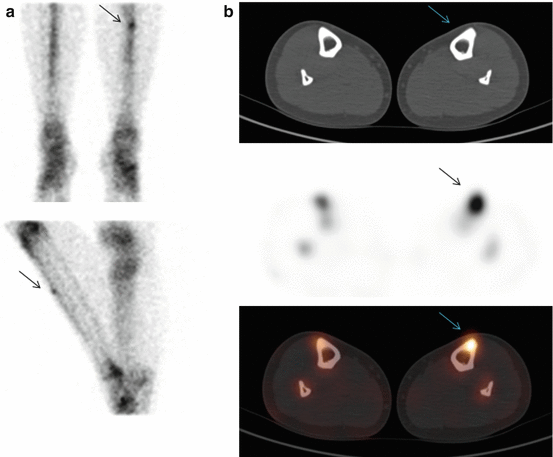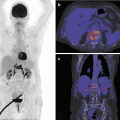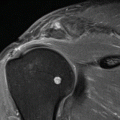Common causes
Medial tibial stress syndrome
Stress fracture
Compartment syndrome
Rare causes
Muscle overuse: strain, rhabdomyolysis
Trauma: interosseous membrane, syndesmosis
Osteomyelitis
Benign and malignant tumors
Metabolic insufficiency fractures
33.2 Medial Tibial Stress Syndrome (MTSS)
33.2.1 Introduction
Medial tibial stress syndrome (MTSS) has been a common name in the nuclear medicine literature used for a cortically localized hyperactivity on bone scintigraphy associated with exercise-induced lower extremity pain, following the first description by Holder and Michael (Holder and Michael 1984). Recently, Yates and White redefined MTSS as “pain along the posteromedial border of the tibia that occurs during exercise, excluding pain from ischemic origin and signs of stress fracture, and with diffuse painful palpation over a length of at least 5 cm” (Yates and White 2004). This definition was an update from the more commonly used clinical term “shin splints” which was introduced in 1966 by the American Medical Association as “pain and discomfort in the leg from repetitive running on a hard surface or forcible, excessive use of foot flexors.” Because excessive muscular traction and stimulation of osteoblasts in Sharpey’s fibers crossing the periosteum has been implicated in the pathophysiology along with cortical thickening seen on radiographs, “periostitis” has also been a popular name in clinical and radiological literature. The lack of official definition and terminology has somewhat hampered comparison between studies (Moen et al. 2009).
In fact, MTSS is one of the most frequent forms of exercise-induced leg pain, with incidences ranging from 4 to 35 % (Clanton and Solcher 1994), and has been reported in military personnel, runners, jumping athletes, rhythmic gymnasts, and dancers. It is an unresolved question whether MTSS and stress fracture are both part of the same continuum in which MTSS, if left untreated, could lead to a full stress fracture or that these should rather be regarded as two separate entities that may co-exist (Beck 1998).
33.2.2 Examination Techniques
Three-phase bisphosphonate bone scintigraphy: (1) dynamic angiographic phase, (2) static anterior and lateral blood pool phase images, and (3) delayed bone phase images with anterior, posterior, medial, and lateral views of the lower legs, preferably from the knee to the ankle (large view camera).
33.2.3 Image Interpretation
Holder and Michael were the first to describe bone scan abnormalities in MTSS, demonstrating an abnormal uptake of the posterior cortex of 1/3 of the tibia in the delayed bone phase (Holder and Michael 1984). This has been typically described as a line-shaped aspect; located at the posteromedial or anteromedial border, either proximal, midshaft, or distal; of lower-grade intensity; and without alterations in blood flow appearing in the early first or second phase (Fig. 33.1). Localization can be unilateral, although often bilateral with a degree of asymmetry. The time to recover from MTSS has been reported to be between 4 and 20 weeks.


Fig. 33.1
Images of a 25-year-old male with lower leg pain after exercise. Anterior (left) and lateral (right) planar bone scan of the lower legs, showing the typical aspect of MTSS in the left tibia (arrows)
33.2.4 Comparative Literature Results
Batt et al. (1998) and Gaeta et al. (2005) prospectively compared bone scintigraphy with MRI and found a similar sensitivity and specificity for the diagnosis of MTSS in symptomatic persons, i.e., 74–84 % and 33 % for bone scanning and 79–88 % and 33–100 % for MRI. Both studies used clinical parameters as gold standard. In the study of Batt, this was exercise-induced lower leg pain of less than 3 months duration associated with palpable tenderness along at least 5 cm. of the posteromedial tibia, without clinical evidence of compartment syndrome or stress fracture. In the study of Gaeta, inclusion criteria were a history of lower leg pain of less than 1 month without trauma or abnormalities on radiographs. Batt studied asymptomatic persons with both imaging modalities and found a high number of similar abnormal findings on bone scan as well as MRI, hence low specificity, while Gaeta found 100 % specificity on the basis of normal MRI findings in 10 asymptomatic persons. Beck et al. (2012) in a prospective study on 40 patients found equal reliability for all image modalities except radiography but found no significant relationship between clinical healing time and severity scores for any imaging modality.
In the study of Gaeta et al. (2005) high-resolution CT scan showed osteopenia changes in the tibial cortex with a sensitivity of only 42 % but specificity of 100 %. This high specificity could be interesting for the accuracy of SPECT combined with high-resolution CT in an integrated SPECT/CT scanner, but information from studies comparing MRI with SPECT/CT is currently not available. In this respect, it should be considered that MRI is more desirable from the perspective of avoidance of radiation exposure, especially in young persons.
33.2.5 Conclusion
Three-phase bone scintigraphy can support the clinical diagnosis of MTSS in a patient with lower leg pain and differentiate with a stress fracture. However, similar abnormalities on bone scan may also be seen in asymptomatic persons.
33.3 Stress Fracture of the Lower Legs
33.3.1 Introduction
Most stress fractures in sports medicine occur in the tibia, accounting for 24 %, followed by the tarsus (18 %), metatarsus (16 %), fibula (16 %), femur (7 %), pelvis (2 %), and spine (1 %) (Patel et al. 2011). Repetitive and excessive stress and bending on the bone occurs, leading to acceleration of normal bone remodeling with bone resorption outpacing bone formation in the tibial cortex, causing microfractures and eventually a full stress fracture. Stress fractures have traditionally been reported in military recruits, but today athletes at all competition levels of sports and an increasing number of “recreational” athletes with repetitive, high-intensity training may be affected, especially in long-distance walking, running, jumping, and dancing and in female athlete triad.
33.3.2 Examination Techniques
Three-phase bisphosphonate bone scintigraphy. Dynamic angiographic phase followed by static blood pool phase and delayed bone phase images of anterior, posterior, medial, and lateral views of the lower legs.
33.3.3 Image Interpretation
Examination with nuclear techniques was described from the 1970s. Zwas et al. established a classification system of the severity of stress fractures in the tibia (Fig. 33.2) (Zwas et al. 1987). Today, this system is still widely used for the diagnosis as well as to distinguish between stress fracture and MTSS on the basis of the characteristics of the static, delayed bone phase scan. In this grade I consists of a small, ill-defined lesion with mildly increased activity; grade II is larger than grade I, with a well-defined, elongated lesion with moderately increased activity in the cortical region; grade III is a wide, fusiform lesion with highly increased activity in the corticomedullary region; and grade IV is a wide, extensive lesion with intensely increased activity in the transcorticomedullary region. Figure 33.3 is an example of a small grade I stress fracture of the tibia. According to Holder and others, stress fractures in the tibia and/or fibula usually have increased vascularity in the blood flow and/or blood pool during the acute and subacute phases, i.e., first weeks after onset of symptoms. This hypervascularity is spatially in accordance with the hot spot on the delayed bone phase. Mohan et al. (2011) recommended lateral blood pool images as an optimal method for evaluating vascularity.



Fig. 33.2
Zwas classification of stress fractures. Four grades (I–IV) of stress fracture evolution as seen on bone scintigraphy are presented schematically (a) and in actual bone scintigraphies (b) (Reprinted by permission of the Society of Nuclear Medicine from Zwas et al. (1987). Figure 1)

Fig. 33.3
Images of a 22-year-old active recreational runner with pain in the left lower leg. Planar bone scan (a upper left) shows focal uptake (arrow) in the left tibia. Corresponding SPECT/CT slices (b upper right) show an unequivocal hotspot in the left tibial cortex, consistent with a grade I stress fracture
Approximately 17 % of fractures will be bilateral (Courtenay and Bowers 1990). In long-distance runners, the most common site is the distal third of the tibia. The posterior aspect of the upper third is the most common site in children and elderly (Van der Wall et al. 2010). The vast majority of fibula fractures are in the distal third. Positive delayed bone phase usually returns to normal in 2–3 months for stage I and II lesions but can persist for more than 6 months in stage IV.
33.3.4 Comparative Literature Results
Three-phase bone scintigraphy has been the confirmation test for stress fractures in most previous studies because of its high sensitivity of 74–100 % (Gaeta et al. 2005; Fredericson et al. 1995). Negative bone scans exclude a significant stress fracture lesion. Ishibashi et al. compared bone scan and MRI in 31 patients, in whom the diagnosis was made by clinical findings and conventional radiographs with or without MRI. They concluded that MRI and bone scan showed an equivalence for early diagnosis and grading, but MRI was preferable as it provided more diagnostic information on the surrounding soft tissue, had a higher specificity (Ishibashi et al. 2002), was superior for detection of early stress injury (Gaeta et al. 2005), and was the imaging modality with the closest relation to time to healing (Beck et al. 2012).
Presently, there are no published prospective studies examining tomographic SPECT/CT for evaluation of stress fractures in the lower leg. Groves et al. (2005) compared CT with bone scanning and found the detection rate of CT much less than scintigraphy. Interestingly, these authors pointed to the potential use of quantification at fracture sites.
33.3.5 Conclusion
Bone scintigraphy has a high sensitivity for the diagnosis of stress fracture of the lower legs, while differentiating from other causes of exercise-induced lower leg pain.
Stay updated, free articles. Join our Telegram channel

Full access? Get Clinical Tree






